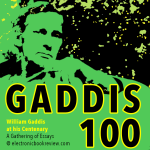fictions present
Gaddis Centenary Roundtable: Translating Gaddis

This roundtable discussion of translating William Gaddis's fiction, with Spanish translator Mariano Peyrou, Portugese translator Francine Osaki, and Ukrainian translator Max Nestelieiev, took place online on September 3rd 2023. Russian translator Sergey Karpov and Japanese translator Yoshihiko Kihara, unable to join on that day, sent written responses to some of the roundtable questions, which have been incorporated below where the relevant question was asked. The transcript has been reviewed, annotated, and lightly edited for clarity and cohesion by roundtable moderator, Marie Fahd.
William Gaddis’s Frolics in Corporate Law

Lisa Siraganian, the J. R. Herbert Boone Chair in Humanities in the Department of Comparative Thought and Literature at Johns Hopkins University, applies her expertise in legal theory to Gaddis’s penultimate novel. Following discussions on business law and the controversial notion of corporate personhood, Siraganian reads Gaddis's fourth novel to explore how a business-dominated legal culture transforms our conceptions and narratives of the individual person.
Total Eclipse: A Rearview Review of Rhythms

A total solar eclipse occurs when the moon slides between the sun and the Earth, aligned precisely so that the lunar body appears to block the solar surface entirely from view. In this autobiographical essay, Steve Tomasula, an Illinois-based writer known for collaborative image-text assemblages, from TOC to Ascension, that convey how and why humans’ existential sense of reality can vary so radically across time and space, recalls an April 2017 Midwestern road-trip pursuing the path of the total eclipse. In Tomasula’s account of the totality, the multiple meditations surrounding this predictable celestial event only intensify the sublimity of the shared experience and its disruptive systemic effects.
Gaddis Centenary Roundtable: Para-Academic Venues for Discussing Gaddis and Other Innovative Fiction

This roundtable discussion took place online in August 2023: it has been lightly edited for focus and clarity. The Chair was Ali Chetwynd, with Jeff Bursey, Victoria Harding, Chad Post, Edwin Turner, Chris Via as speakers. More about each participant, including links to their individual projects, can be found in their electronic book review author biographies.
Faire Exchange No Robbery: Critiques of Anthologies and Contracts in an Unpublished Gaddis Play

Written by William Gaddis in the mid-1940s, “Faire Exchange No Robbery” is a short, mock-Elizabethan play in verse, about early poetry anthologies and the death of Christopher Marlowe. Jeffrey Severs brings this unpublished document to light, finding in it the germ of Gaddis’s career-long interests in art’s relationship to commerce, and in the significance of contracts.